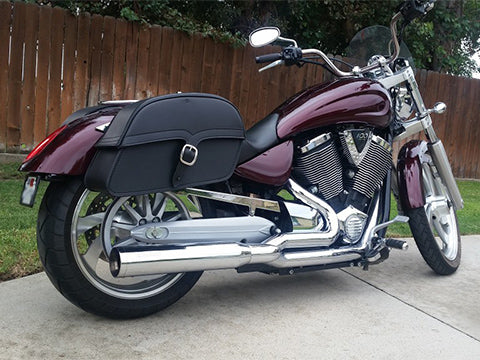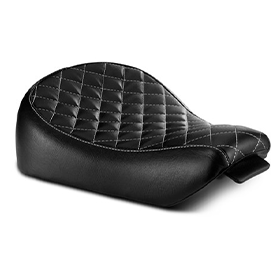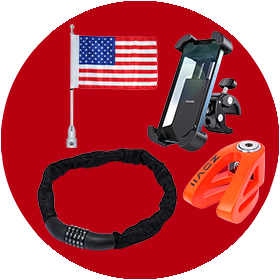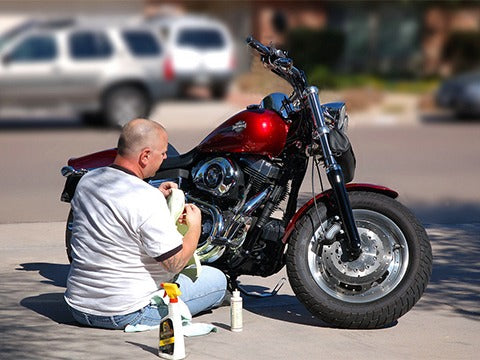ven if you weren’t a Boy Scout, you are probably familiar with their motto, “Be Prepared.” Because you never know what may happen when you’re out for a ride, whether it’s a weekend getaway or just a quick trip to the grocery store, so it’s better to be prepared. I’d like to share what I call my saddlebag essentials. I’ll give you the summary list first, and then talk briefly about the items. Here’s the list in no particular order:

- Raingear
- Tool kit
- Tire repair kit
- Air compressor
- Jumper cables
- Work/Nitrile gloves
- Flashlight
- Glow sticks
- First aid kit
- Zip ties
- Rescue tape
- Camp stool
- Bottled water
- Phone charger or spare battery
- Mylar blanket
Raingear – It should go without saying that riding wet ain’t as much fun. Always have the raingear available. Even if you are the type that only likes to ride on sunny days, it’s inevitable that the one time you leave the raingear out, it’s going to rain. Like most of the things on this list, I’d rather have it and not use it, than not have it and need it.
Tool kit – Most (new) bikes come with some kind of tool kit, but I have yet to see one that was adequate. Do yourself a favor and invest in a decent compact tool kit. You don’t want to be stuck on the side of the road without the means to do minor repairs. Save the calls to the tow truck for when it’s something you can’t manage yourself.
Tire repair kit and air compressor – I rode with a guy that pulled a trailer with (among other things) a spare tire in it. Most of us don’t go to that extreme and make do with a tire repair kit and a bike operated air compressor. Short of a catastrophic tire failure, they’ll get you back on the road and at least get you to bike shop to have the tire replaced. While it may take 20 minutes to refill the tire after plugging it, it still beats waiting for the tow truck.
Jumper cables – They make surprisingly compact jumper cables that are perfect for carrying on your bike. You never know when you or your riding buddy is going to leave the lights on at a rest stop for too long.
Work gloves or nitrile gloves – The last thing you want to do is get your hands or riding gloves dirty while making a roadside repair. So invest in a good pair of work gloves. Alternatively, a couple pair of nitrile gloves works. They are cheap, disposable, and take up less room in the saddlebag than work gloves. On the downside, they can tear easily, so it pays to carry more than one pair if you go this route. I personally carry both.
Flashlight – Cheap LED flashlights can really come in handy if you get stuck after dark. Some people like to get the kind that strap to your forehead, leaving both hands free. I have both types. Just be sure to test the batteries frequently and/or carry spare batteries. A dead flashlight is almost worse than no flashlight at all because it makes you feel like an idiot when you’re already stressed out on the side of the road.
Glow sticks – When you are broke down on the side of the road, you don’t want is to be sideswiped by a cager. They make some neat LED flashing hazard lights that are small enough to carry in the saddlebag, but again, they rely on batteries. Chemical based glow sticks will last 8 hours. While they don’t require batteries, they are one use only and need to be replaced once used. I carry three; one for beside the bike and the other two to be placed at 15 foot intervals behind it.
Zip ties and rescue tape – You may have noticed that there are a lot of zip ties on your bike. They are important for cable management. In the event you have to cut one (or more) to effect a roadside repair, you don’t want to have to drive off without re-securing them.In a pinch, you can sometimes use them to secure other loose parts and you may want to carry multiple sizes. Rescue tape is better than duct tape for handling high heat.
First aid kit – They sell premade first aid kits that are surprisingly complete, yet small. They usually do this by having very limited supplies of each item. If you take the one dose of acetaminophen or use the one adhesive bandage, you’ll need to remember to restock the kit when you get home. It’s usually cheaper to just buy a small container and build your own kit. Adhesive bandages in all sizes are convenient, but a few sterile gauze pads and a roll of medical tape may be more practical.
Camp Stool – Yes, they make camp stools small enough to pack in a saddlebag. Granted, they aren’t comfortable enough to sit on all day at an outdoor concert, but I’d rather sit on it than in the broken glass and gravel on the side of the road while working on my bike.
Bottled water – You need to stay hydrated. When you are on the roadside due to an emergency stop, you don’t always know how long you’ll be there. Keep an extra bottle or two of water handy just in case.
Phone charger and/or spare battery – Given that mobile phones have become essential in modern society, it pays to have a charger for it on the bike. If the job is bigger than you can handle on the roadside, you can’t call for the tow truck if your phone is dead. If your bike doesn’t have a battery accessory port, you’ll also need to invest in one of these. Alternately, if your phone uses a removable battery, you can carry a backup; just make sure it is charged before you leave home. Yes, I have both.
Mylar blanket – Even with all the other things on this list, sometimes you are just stuck waiting for the tow truck. Mylar blankets are sold in camping supply stores and online. An 84” x 52” blanket comes in a package no bigger than a credit card and just a quarter of an inch thick, yet retain 90% of your body heat. Great if you are on the side of the road and the temperature drops 20+ degrees at sundown. They are inexpensive and usually sold in quantity for a further discount. It doesn’t hurt to buy them in bulk. They are small enough to carry more than one and cheap enough to be disposable. You’ll never fold it back up that small again anyway.
Properly packed, all this stuff fits in a single saddlebag with room to spare and since they come in pairs, you still have another one if necessary. You may be lucky enough to never use most of the stuff, but again, better safe than sorry.
What’s in your saddlebags? Anything you carry that I left off my list? Feel free to let me know in the comments.















Leave a comment
All comments are moderated before being published.
This site is protected by reCAPTCHA and the Google Privacy Policy and Terms of Service apply.